http://www.bharat-rakshak.com/LAND-FORCES/History/WW2/70-Glimpses.html
July 10, 1944. 5th Maratha Regiment's Yeshwant Ghadge, all of 22, was caught in a mortal combat in the Upper Tiber Valley of Italy. Except for his commander, his platoon had been wiped out by enemy machine-gunners. With no alternative left, Ghadge rushed the machine gun nest, lobbing grenades, knocking off the gun and the gunner. He charged, shot another enemy. With no time to change his magazine, Ghadge clubbed to death two remaining enemy gunners. Ghadge finally fell to an enemy sniper.
India's memories of the World War II are made of such tales of exceptional valour, was India's biggest and worst war.
Umrao Singh had held onto an advanced gun position against four assaults by Japanese troops.
Despite injuries from two grenade attacks, Singh fought on. When he was discovered hours later, bodies of 10 Japanese were lying around him.
Though the war was not India's, Indians were among the most heroic, borne out by the fact that they won over 4,000 gallantry awards, among them almost 20 Victoria Crosses.
Abdul Hafiz, 9th Jat Infantry, of the British Indian Army and was posted to Imphal, to defend the northeast borders where the Japanese were pushing in.
Just 25, and a Jemadar under British officers, Hafiz led a charge up a bare slope and then up a steep cliff despite machine-gun fire.
He pressed on, eliminated the enemy who vastly outnumbered Hafiz's platoon, but succumbed to his injuries.
Hafiz was awarded the Victoria Cross for the last act of his life.
Similar was the story of 22-year-old Yeshwant Ghadge whose act of exceptional courage came in the Upper Tiber Valley of Italy on July 10, 1944.
His entire section, except the commander, were killed or wounded from machine gun fire. Ghadge rushed to the machine gun location, throwing grenade and knocking off the machine gun and its firer and then shot another.
With no time to change his magazine, Ghadge clubbed to death two other remaining members of the machine gun crew. Ghadge like thousands of his Indian counterparts too fell to an enemy sniper and died.
Many of the Indian VCs were won in Burma and other regions of India's northeast.
If the Japanese forces, along with Bose's Indian National Army, had succeeded in their efforts to push into India the World War II would have had a different meaning for Indians.
Some of Independent India's great warriors too were World War II veterans.
Marshal of the Indian Air Force Arjan Singh earned his first recognition as an outstanding flier in the World War II.
Stationed at Imphal valley, his unit played a key role in resisting a siege. Singh was awarded the Dinstinguished Flying Cross by Lord Mountbatten, the then chief of the South East Asia Command.
While Indians played a pivotal role in safeguarding the northeast and Burma, they were also valiantly in action in places as far as Africa.
The Fifth Indian Division fought against the Italians in Sudan, and against the Germans in Libya.
Indians also played a critical role in protecting the Iraqi oilfields, which had by then become a key installation for the British Empire.
The Fifth Division also was part of the occupational force of Malaya. And later it went to Java to disarm the Japanese troops.
The Fourth Indian Division fought in North Africa, Syria, Palestine, Cyprus and then in Italy.
World War II was also the only occasion when the American troops were ever stationed in Indian soil.
They were deployed all over Northeast, and some units were even based in New Delhi. WW II veterans recall the lavish lifestyles of the Americans, who earned more than even British soldiers.
The Americans also played key role in flying supplies from Calcutta, Karachi and other ports to Burma, China and other theatres of war in the region.
They also played an important role in developing road network in the northeast.
India was a cultivation base for upping supplies for the Allies.
Across the country rationing and shortages were felt.
In Calcutta the great famine of 1943, triggered by rice disease brown spot, was accentuated by the war-time shortages. An estimated 3,000,000 people died in the famine.
The war's crippling impact on British Empire eventually helped speed up India's freedom.
But as is wont in India, the legacy of the 2.5 million Indian braves has lost the battle to neglect.
India's only living Victoria Cross winner of WW II, Honorary Captain Umrao Singh, 85 gets a meager Rs 80 as monthly pension.
Umrao Singh had held onto an advanced gun position against four assaults by Japanese troops.
Despite injuries from two grenade attacks, Singh fought on. He held the gun pit until dawn, and was found face down in the mud surrounded by ten lifeless Japanese soldiers and holding a hand-spike he had used in hand-to-hand combat. Singh survived and was awarded the Victoria Cross.
Khukris unsheathed, Gurkha troops charge the enemy lines in Burma.
Indian soldiers storm a German trench, after exploding it with hand grenades.
A Lt Colonel from the 20th Indian Division accepts the formal surrender of a Japanese Commander at Saigon, Vietnam, in September 1945.
A group from the 152nd Para Battalion displaying the Japanese flag they captured at Tangkhul Hundung. ( Photograph: Bharat-Rakshak.com )

An RAF NCO helps an Indian airman to load the ammunition belts into the chutes built into the undercarriage leg fairing. Some detail of the Universal bomb carrier fixed to the stub wing can be seen in this image.




Sikh soldiers of the 8th Army with local boys in San Felice, Italy.

Sikh soldier of the 11th Sikh Regiment with a captured Nazi flag in Italy at the end of the Second World War.
Flt. Lt. M.S. Pujji and Hurricane IIB "I was posted to No.253 Squadron RAF, flying Hurricane IIB fighters from RAF Kenley, which is a couple of miles south of Croydon. We were a mixed bunch, with pilots also from Poland, America, Canada and Australia. Equipped with twelve machine guns, our hurricanes were extensively flown day and night, to intercept German bombers and reconnaissance aircraft."
Cassino Memorial, Italy
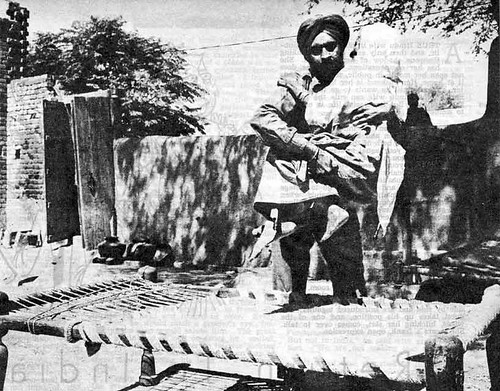
Deserted by all, on the Pakistani retreat from Salian village in the Sialkot sector, Hasana Begum, 85, is helped to her cot outside her small home by Sikh soldier.
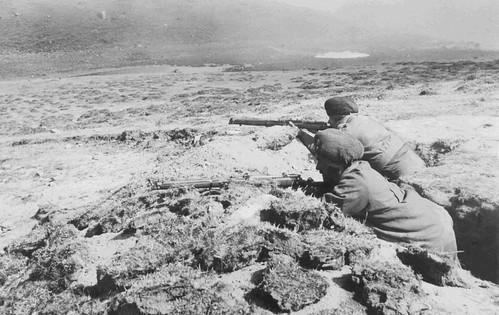
A pair of jawans manning a forward post, somewhere along the Indo-China border. Circa 1962

Sikh Officer discusses a war plan with other senior Indian military commanders.
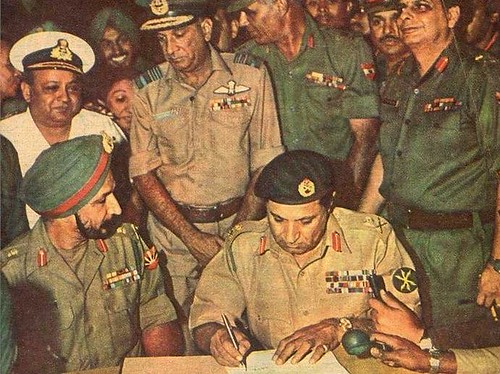
Lieutenant General A.A.K. 'Tiger' Niazi, Commander of the Pakistan Army in the East, signs the Instrument of Surrender in the presence of Lieutenant General Jagjit Singh Aurora.
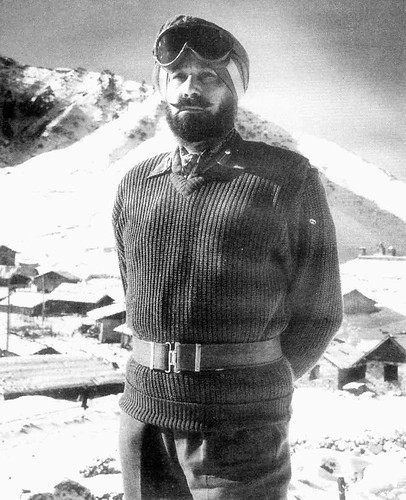
Lieutenant General Harbakhsh Singh, Padma Bhushan, VrC, was the GOC-in-C Western Army Command during the 1965 Indo-Pak War. Much of the success of the ground war was attributed to his brilliant military tactics
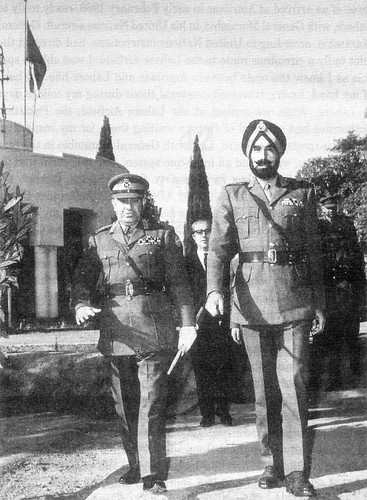
Lieutenant General Harbakhsh Singh listens keenly as Lieutenant General Bukhtiar Rana, Pakistan Army makes a point during post-war negotiations at Lahore. Officials from the United Nations walk right behind.
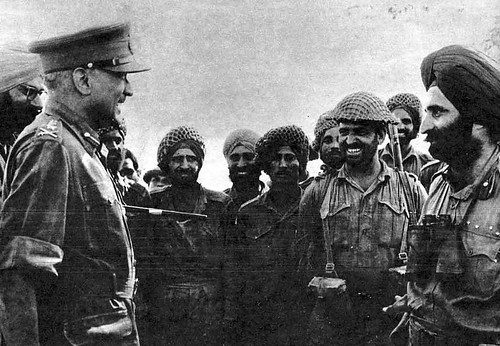
General has a word of congratulation for the soldiers on the bank of the Ichhogil Canal
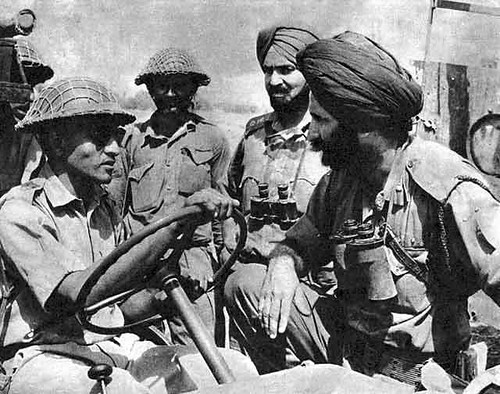
A Pakistani officer arrives in a jeep, after the cease-fire, to seek the permission of the Indian Army to collect the dead and wounded
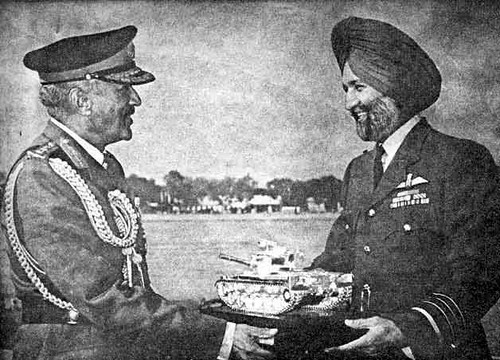
A grateful Indian Army thanks her sister service, the Indian Air Force, for its much-needed support during the 1965 war against Pakistan: Chief of Army Staff, General J.N. Chaudhuri presents a silver replica of a Patton tank to the Chief of Air Staff, Air Chief Marshal Arjan Singh at the Army Day Parade in New Delhi on 15 January 1966.
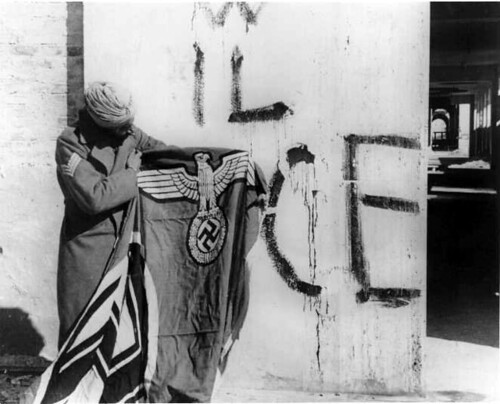
Sikh soldier holds a captured Nazi flag. Circa 1945

A truly spectacular image. In the heat of the moment - Indian soldiers storm a German trench, after exploding it with hand grenades. Circa 1945.
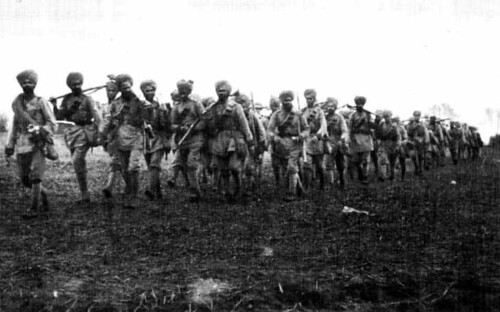
A long way from home: Indian troops at the first Battle of Ypres. This contingent of the 129th Baluchis in the vicinity of the Hollebeke Chateau, 28 October 1914. The photo has been taken by General Gough.
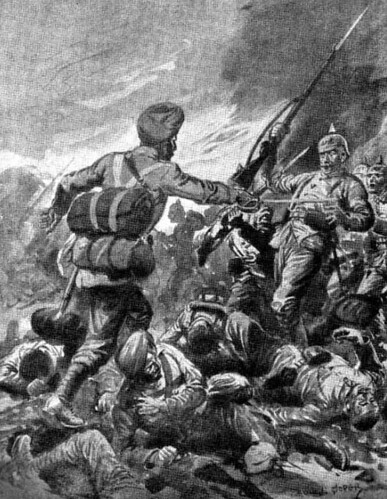
A black & white sketch depicting Havildar Gagna Singh, 57th Wilde's Rifles, in battle. Havildar Singh was awarded the IOM (Indian Order of Merit) by shooting a German officer and killing ten other ranks.

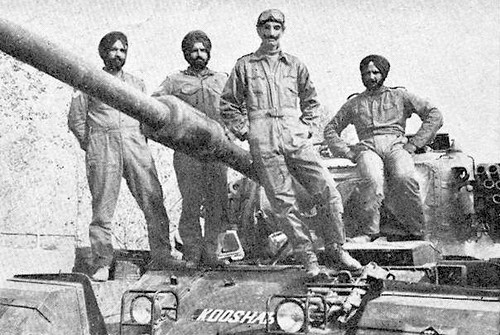

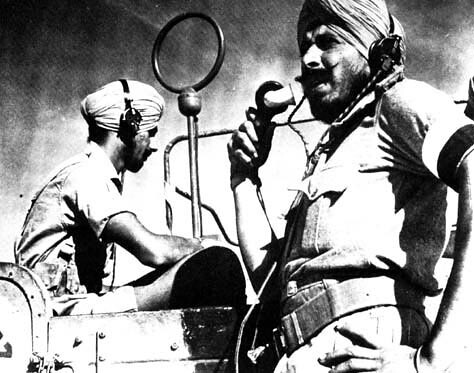
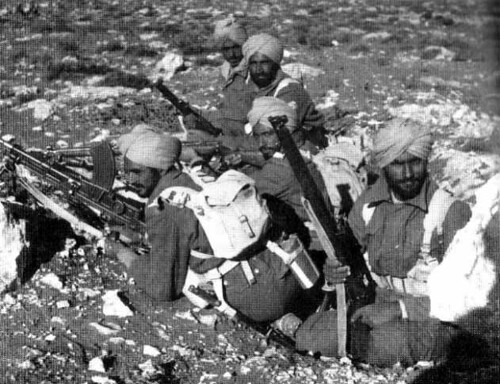
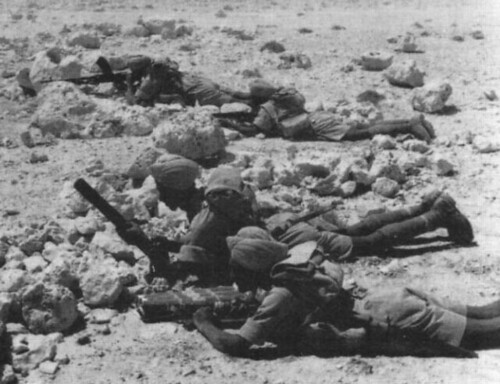
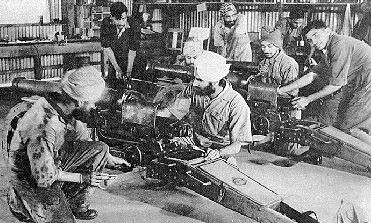
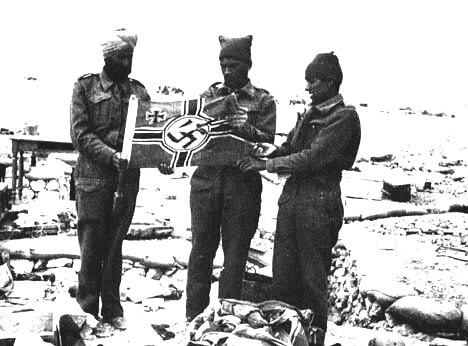

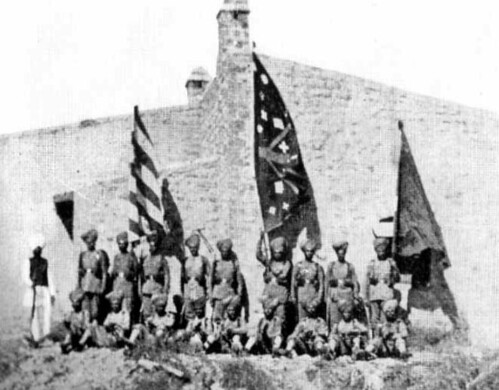


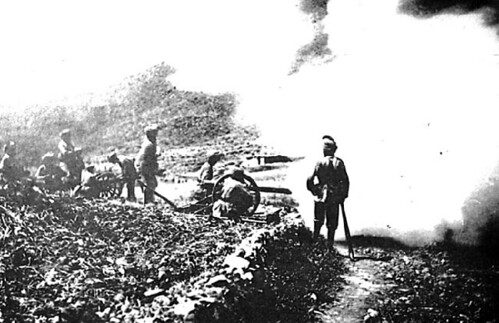
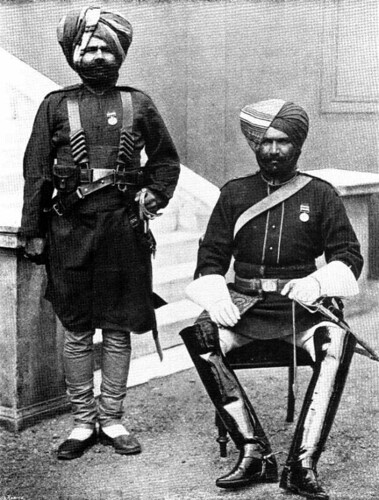
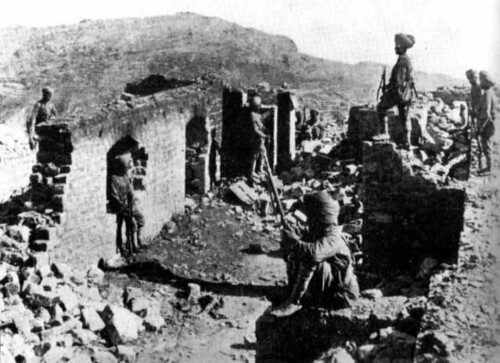

World War I

Former Indian Army Chief, J.J. Singh

Indian Troops

Sikh Commando
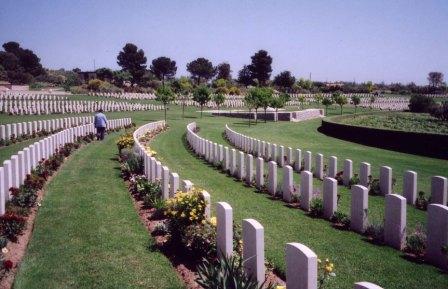
2,197 Sikh war dead buried at Commune of Torino di Sangro, Italy



Sikh Tank unit on the outskirts of a German village
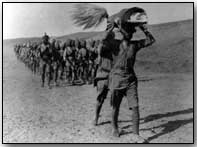
Sri Guru Granth Sahib, Iraq, 1914

Resting after a long day of fighting, Neuve Chapelle, France in summer of 1915.
NEUVE-CHAPELLE MEMORIAL
NEUVE-CHAPELLE MEMORIAL

A French women thanks victorious Sikh troops marching through Paris

Fighting for Paris WW2
"Singh is King" Lebanon

Lebanon

A Lebanese Christian women takes a pictures of UNIFIL troops in Lebanon


Execution of Sikh Prisoners of war
This image forms the last in a set of four tragic photographs that were found amongst Japanese records when Allied troops entered Singapore shortly after the end of the Second World War. The sequence of events is narrated as follows:
1) Japanese soldiers load their rifles and prepare to shoot their prisoners.
2) The blindfolded prisoners sit with target marks hanging over their hearts, and stakes placed in the ground in front of them bearing their number. They sit with dignity awaiting their end.
3) The shots ring out. Some appear to be near misses, and none at this stage appear to be fatal.
4) To ensure the prisoners are dead, a Japanese soldier goes among the wounded with a bayonet. A second soldier can be seen using a pistol to kill any survivors.
A fitting tribute to Sikhs like these and many others who volunteered in their thousands to join the war effort can be found in the words of General Sir Frank Messervy:
“Finally, we that live on can never forget those comrades who in giving their lives gave so much that is good to the story of the Sikh Regiment. No living glory can transcend that of their supreme sacrifice, may they rest in peace. In the last two World Wars 83,005 turban wearing Sikh soldiers were killed and 109,045 were wounded. They all died or were wounded for the freedom of Britain and the world and during shell fire, with no other protection but the turban, the symbol of their faith.”
- Colonel F.T. Birdwood, The Sikh Regiment in the Second World War.